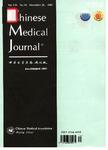Risk factors for bronchiolitis obliterans syndrome in allogeneic hematopoietic stem cell transplantation
Risk factors for bronchiolitis obliterans syndrome in allogeneic hematopoietic stem cell transplantation作者机构:Peking University People's Hospital & Institute of Hematology Beijing Key laboratory of Hematopoitic Stem Cell Transplantation Beijing 100044 China
出 版 物:《Chinese Medical Journal》 (中华医学杂志(英文版))
年 卷 期:2013年第126卷第13期
页 面:2489-2494页
核心收录:
学科分类:0710[理学-生物学] 090603[农学-临床兽医学] 1002[医学-临床医学] 07[理学] 071009[理学-细胞生物学] 09[农学] 0906[农学-兽医学] 0901[农学-作物学] 090102[农学-作物遗传育种]
基 金:This work was partly supported by grants of the National High Technology Research and Development Program of China (Program 863) (No. 2011AA020105) the National Natural Science Foundation of China (No. 30971292) and the Key Program of National Natural Science Foundation of China (No. 81230013)
主 题:bronchiolitis obliterans syndrome allogeneic hematopoietic stem cell transplantation graft-versus-host disease,"antithymoeyte globulin
摘 要:Background The occurrence of bronchiolitis obliterans syndrome (BOS) after allogeneic hematopoietic stem cell transplantation (alIo-HSCT) is rare but severe. We examine the role of pre-HSCT chemotherapeutic exposure, pre-HSCT comorbidities, and transplant-related complications in the development of BOS after alIo-HSCT. Methods A nested case-control study was designed. Cases with BOS and controls matched for the year of alIo-HSCT and length of the follow-up were identified from a cohort of 1646 patients who underwent alIo-HSCT for treatment of hematologic malignancies between 2006 and 2011. Antithymocyte globulin was used in the partial matched related and unrelated matched donor HSCT, or patients with severe aplastic anemia. Results Thirty-six patients suffered from BOS; the mean age at the time of presentation was (32.7±2.4) years, and the mean time to presentation was (474±350) days post-HSCT. A pre-HSCT cyclophosphamide dose of 〉3.2 g/m2 (OR=8.74, P=0.025), chronic graft-versus-host disease (moderate to severe) (OR=12.02, P=0.000), and conditioning regimens without antithymocyte globulin (OR=2.79, P=0.031) were independently associated with BOS. Conclusions We found that higher pre-HSCT cyclophosphamide exposure, a conditioning regimen without antithymocyte globulin, and moderate to severe chronic graft-versus-host disease are significantly and independently associated with BOS. Based on these results, we can identify patients who are at a higher risk of developing BOS after alIo-HSCT, select a more appropriate therapeutic strategy, and improve the outcome of HSCT recipients.



